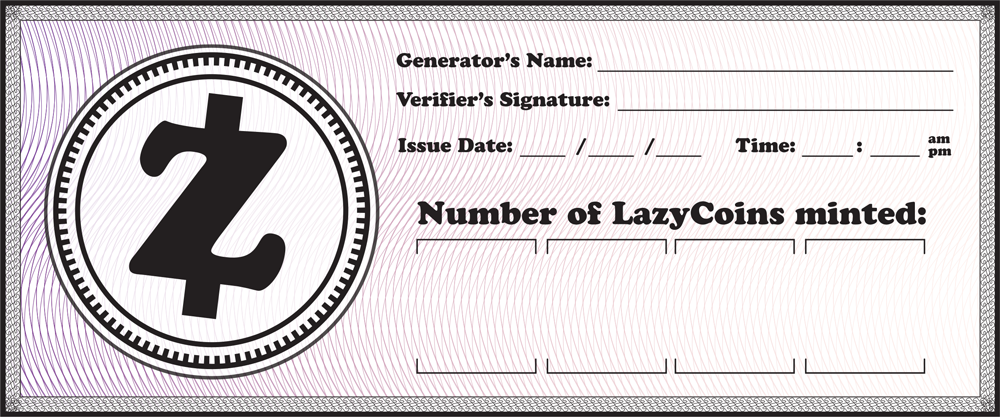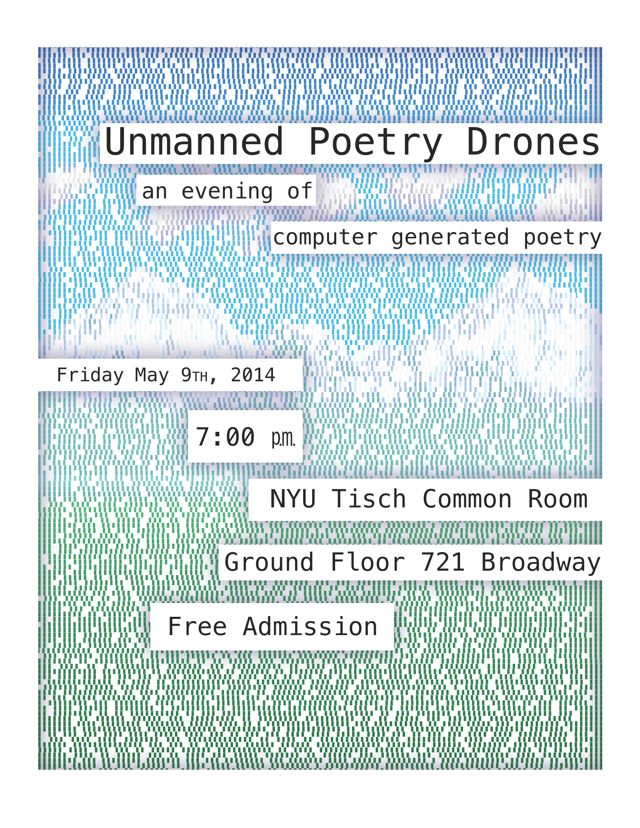
A few weeks ago I created a conceptual currency called LazyCoin with Brian Clifton, Karl Ward, Jon Wasserman, and Surya Mattu. Unlike typical currencies, which aim to represent and store value, LazyCoin is a store for non-value: you produce LazyCoin by doing nothing.
LazyCoin is also an inversion of the BitCoin protocol: the currency is physical and can only be generated by two or more humans in close proximity, in accordance with protocol that we outline in our white paper. We were inspired by Melville’s Bartleby – it’s a currency that “would prefer not to.”
If you’re interested in how LazyCoin works, I’ve included our full white paper below – you can also read a more beautifully formatted version of it here, and take a look at the github repository here.
LazyCoin
A new currency that stores non-value.
1. Introduction
“Why do you refuse?”
“I would prefer not to.”
– Herman Melville
LazyCoin is a currency that quantifies lack of activity. With LazyCoin, the more you do nothing, the more value you create.
2. The Minting Process: Proof of Non-Work
In brief, proof of non-work constitutes one person staring at another person doing nothing.
Minting new LazyCoin requires participation from at least two parties: one or more Generators, and one Verifier. The role of the Generator is to do nothing. The Verifier observes the Generator to ensure that he or she is doing nothing. When the Generator finishes producing LazyCoin, the Verifier signs a blank LazyCoin, making note of the date and the amount of LazyCoin produced. The Verifier gives the newly minted, certified LazyCoin to the Generator to complete the minting process.
The smallest unit of LazyCoin is minted in one minute.
During the minting process, the Verifier may choose to continue his or her normal, productive activity while periodically checking in on the Generator. The Verifier may also produce LazyCoin along with the other Generators. Should the Verifier choose the latter, he or she must receive Verification from the other Generators.
Proper verification requires that all parties remain in line of sight for the duration of the minting process.
The Generator should never do anything while minting LazyCoin. However, under certain circumstances, and with prior approval by a Verifier, the Generator may pretend to do something.
3. Currency Cap
The daily currency cap of LazyCoin is limited by the number of minutes in a day and the number of people on the planet. According to current population estimates, this means that the maximum possible LazyCoins that can be produced in one day is 10,303,200,000,000.
4. Verification Issues and Resolutions: A System of Trust
The extremely young, the extremely old, the incarcerated, the homeless, and others excluded from the productive workforce are the most natural producers of LazyCoin.
However, the extremely young are not mentally developed enough to be each others’ Verifiers, and the extremely old have higher risk of conditions that could compromise their ability to effectively Verify (such as senility or other diseases of the mind).
To protect against potential exploitation, LazyCoin can only be minted by those who are aware they are minting LazyCoin.
LazyCoin is not immune to forgery. Instead, it relies on a system of trust and reputation: if a Verifier is caught forging LazyCoin, his or her reputation in the LazyCoin community will decrease. Verifiers who fraudulently sign LazyCoins or sign LazyCoins minted by “zombie” Generators will inevitably be exposed and removed from the system.
5. Double-Earning
One benefit of LazyCoin is the possibility of minting LazyCoin while simultaneously earning standard currency. For example, a LazyCoin Generator may choose to mint LazyCoin while working a salaried job, simply by ceasing normal work activities and doing nothing. If the Generator earns income through freelance or hourly work, he or she can attempt to simultaneously mint LazyCoin by padding hours or making fraudulent entries on a timecard.
6. Exchanging LazyCoin
As with all currencies, LazyCoin can only be exchanged with those who are willing to exchange it. During the initial phase of LazyCoin minting, we recommend that all LazyCoin Generators accumulate as much LazyCoin as possible and store their earnings under mattresses and floorboards for later non-use.
Unlike typical “fiat” currencies that require mutual participation from multiple parties for transactions to take place, LazyCoin can be exchanged with consent from only one party: the person holding LazyCoin. For example, a person holding LazyCoin could enter a store and deliver LazyCoin in exchange for buying nothing.
Patent
I recently created a project that generates patent applications from literary texts. I ran the LazyCoin white paper through the generator, and produced the following patent: A system and method for ceasing normal work activities. Here’s an excerpt:
The present invention would prefer not to.
The present invention is a currency. The device does nothing. The present invention is nothing. The invention pretends to do something. The invention compromises their ability. The device is possibility. The present invention earns standard currency. The device chooses to mint. The invention works a salaried job. The invention ceases normal work. The present invention enters a store.
Conclusion
Naturally, LazyCoin is an open source project. This github repository contains the white paper detailing the LazyCoin protocol, the LazyCoin patent, and blank printable LazyCoins. Please feel free to make a pull request if you have any suggestions about changing the LazyCoin protocol or any other aspect of the project.
We also plan on creating a LazyCoin ATM: a person sitting alone at a desk in an abandoned office who offers to verify LazyCoin production for anyone who passes by. I’m confident that LazyCoin is poised to forever alter the value of nothing.

